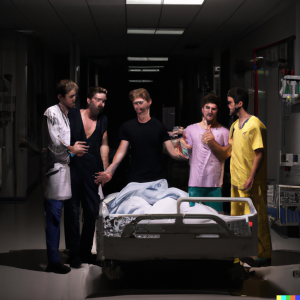I would like to preface this with saying I am using my previous five story summaries I came up with when I first took this class before withdrawing, so I am citing myself, I guess.
1. Classic 3-Part Structure
A mystery, a hero, a bastard, or a demon. A man that shakes his hand calls him something different than the one that kisses his gun. One would never expect he would answer to “Dad” with his deemed profession, though. A killer for hire, Cedric Agrumin hears multiple names, but he never shakes the feeling of shame when his young son and daughter call him familiarly. He hides his line of work from his family the best he can with “business trips” and “signature deals,” but how long will it be before his children realize the truth?
During a hit turned lengthy by some particularly hardy prey, one phone call makes Cedric feel like he’s the man currently struggling to breath at his feet. His phone. He brought his family phone instead of one of his many work burners. As the only guardian to his kids, it was a matter of time before he made a mistake, and they made a sensible decision to check up on their father.
How does one assuage their son after their daughter sneaks out while simultaneously checking pulses to make sure they stop? A shocking accident like this can only happen once before his consequences, and many, many enemies, catch up to him. With his two halves bleeding together, his occupation and filial bonds, Cedric needs to pick which one to keep as his shift and this phone call comes to an end.
2. Kishōtenketsu 4-Part Structure
Ki: By the ocean, calm and free, a late man in his thirties lives in a house by himself. With the sea as his muse and the moon as his light he writes himself into a lonely oblivion. As he walks the beach one evening, he spots a barely clothed man passed out on the sand with bleeding legs. Panicked, he takes him back to his own house nearby to administer care and call someone. As he’s laying the man in his shower to clean off the sand and blood, the water hits his guest’s legs and turn into a sparkling fish tail. Awed and terrified he falls back as the man starts to wake up. The injured creature hisses, its tail flapping, and gills expanding under his torn shirt while our protagonist looks on with a new interest, intent, and muse: this merman he brought home.
Shō: Knowing the merman would be taken for malicious research or phenomenon, the writer does not call anyone and sets to befriend the being. Learning his name via harsh kiss (the creature claiming it was to learn his native tongue) to slowly becoming friends as they learn about each other’s upbringing and preferences, the two develop a romantic relationship. With the two in a world that does not accept them, they only need each other.
Ten: Occasionally the merman will cough, however even after he drinks, bathes, and sleeps in water- he is not able to stay. His gills are starting to dry out for he is not human and cannot exist on land.
Ketsu: The merman is ultimately persuaded by the protagonist to go back to the sea and occasionally visit when he can. In a tearful and hurried goodbye, the merman swims back into the sea and after weeks of waiting turns into months into years, the writer can do no else but return to his house and never walk the beach again for it would be too heartbreaking to walk and hope.
3. Episodic Structure
Episode 1: A young boy is seen sitting at a lunch table in a crowded public-school cafeteria. His expression is angry as he sits alone, looking at all the full tables of children his age laughing and having a good time. A hand squeezes his juice pack so hard the juice comes out. When a group of girls and boys walk by and sneer at his measly lunch and dour demeanor, he abruptly stands up and throws a lunch tray that is not his at the group. After a couple gasps and scattered laughs, the lunchroom explodes into a frenzy of kids throwing their food with him in the middle. Lunch ladies and teachers try to calm the chaos, but it only truly stops when he throws an apple and makes a kid bleed. The fun has turned dangerous, and he is escorted to the principal’s office where he sits, unrepentant.
Episode 2: The same boy, now a young man, is more rough looking now. He has a healing black eye that makes it hard to see out of. A nose that’s clearly been broken before and healed wrong. Standing in an alley, waiting for a hookup, instead of a juice box he squeezes a knife in his jean pocket to remind himself it’s there. Anxious on the inside, but as solid as the brick he’s leaned against on the outside, he glances at the entrance to the alleyway and sees a different guy than the one he usually meets. Now in defensive mode, the stranger walks nearer and he tenses up, opening the knife in his pocket, giving himself a small nick. Words fail him as the new guy saddles up and starts to reach inside his jacket. In fight versus flight, he pulls the knife out and stabs the guy in the neck before either can comprehend what just happened.
Episode 3: The same young man, now slightly older, is seen sitting at a lunch table in a crowded public prison. His expression is angry as he sits alone, looking at all the full tables of young, old, and in-between adult men scowling and eating slop for the nth time. A hand squeezes his juice pack so hard the juice comes out. When a group of older men, those who have run this place for years with invisible rules separate from the one’s they all abide, walk by and ignore him completely, he abruptly stands up and throws a lunch tray that is his at the group. After a grunt and a nearby whistle from a guard, the lunchroom stays quiet with him in the middle. A guard starts to make his way towards him and with a last-ditch effort to feel something he throws a punch and ends up on the ground before it hits. Biting concrete and willing the tears in his eyes not to fall, he is escorted to solitary confinement where he sits, repentant.
4. Surrealist Mode
A dystopian world, one that seems familiar to all the others, lies our scene. Miserable, harsh, and oppressive, the rich stand at the top, with the poor at the bottom. Our protagonist has lived her whole life on harmful streets. However, she can see people’s words. Their colors, their aura. When they speak a color comes out and wraps them in its essence. Being born at the bottom the only colors she is used to seeing are dry grays, dull blues, and dark featureless colors. Until one day she is pulled alongside a crowd she does not belong in and finds herself staring up at a color she has never seen. A tall woman, wrapped in a vibrant color of war that drips across her body as a sign of power, of change, of mutiny. An uprising. Of an equality those at the bottom, even in their wildest dreams had dared not hope of. In awe she becomes obsessed with this color, it’s passion and intensity, and vows to follow this woman until her dream has come true. Until she can see that color flood the streets and overtake the drab hopelessness she has become accustomed to her whole life. She will follow.
5. Personal Fictional Story
A girl grew up and only knew love from her cat. Her parents were there, her siblings were there, but only did the cat love her and she love it. The cat had a tree and would climb it for her. Wait for her in a single spot every day on that tree. Growing up, she turned into an adult and the cat turned old. With the love from the cat, she was okay. One day, of course, the cat dies. And she cries. The tree is empty. Life goes on.
A kitten pops into her life. Young and scared and confused. The night she is brought home the kitten cannot climb the tree and it remains empty. I cannot love her, she thinks. I cannot love this kitten like it deserves. She thinks about returning her to her mother. She sleeps on the couch and leaves the kitten alone in the room with the empty tree.
Half the night wastes away like the girl on the couch. Not being able to stand another second on the couch she gets up. When she enters her room the kitten is not on the bed. Her heart beats so treacherously hard in her chest as she finds her kitten. Not unable to climb the tree but sleeping soundly in the spot her black and white had waited for her. Life goes on.









